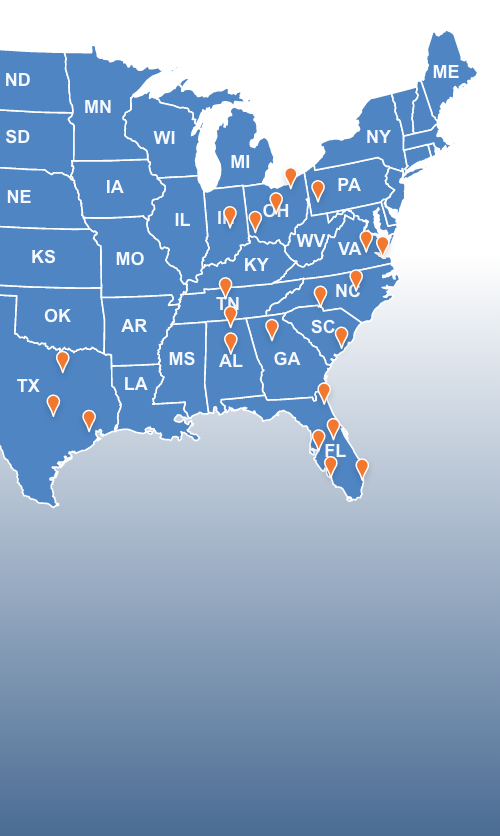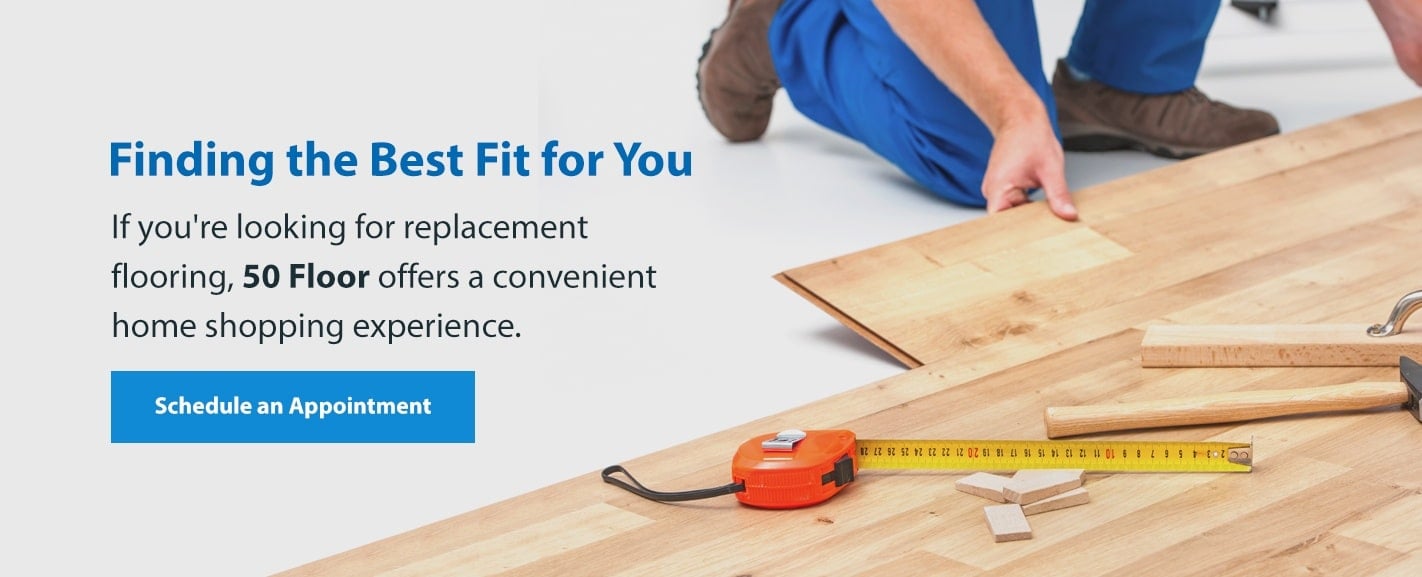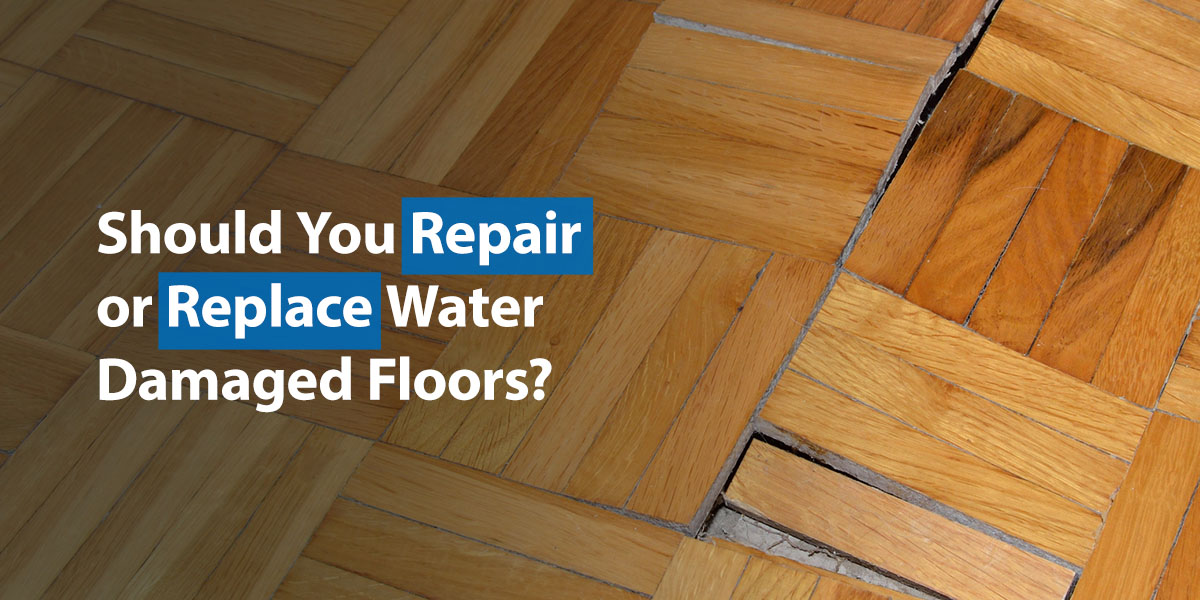

Sometimes, even professionally installed and well-maintained floors can experience water damage. Whether it’s over a long time or all of a sudden, water heater leaks, broken pipes, and natural disasters like hurricanes or floods can all damage floors, leaving you wondering whether to repair or replace your floor.
The type of flooring, the extent of damage, and the cost of repairs versus replacement will help determine which decision is best for you. Here are some tips for dealing with water-damaged floors.
How to Spot Water Damage on Floors
If you’ve experienced a leak, flood, or another water-related incident, it’s important to check the flooring around the affected area. Pay special attention to signs of water damage on hardwood floors, as hardwood is particularly susceptible to water damage. The longer your flooring was wet, the deeper and farther the water may have traveled.
Odds are, you’ll know if the floor has sustained damage when you inspect it. Here are some specific water damage signs to look for:
- Buckling: Buckling occurs when the flooring detaches from the subflooring beneath it. Your floor may separate at the seams or peel upward.
- Crowning: When flooring loses moisture, it can shrink on the underside. This moisture loss leaves planks rounded, with a high point in the middle and low points on the edges.
- Cupping: When your floor absorbs moisture, plank edges may curl upward — leaving the middle of the plank with a slight depression.
- Discoloration: Any change in color may indicate mold or mildew. Inspect new stains and dark spots for growth.
- Warping: Any abnormal bubbling, peeling, or cracking in the flooring could indicate damage.
- Odor: Unusual odors could indicate mold and mildew in the flooring or subflooring. If there is water under your flooring, it can be particularly damaging.
If the flooring shows only minor indications of damage, you may be able to resolve the issues by thoroughly drying the affected area. If not, you’ll need to consider restoration options. Some damage only appears after several hours, so give your flooring plenty of time to dry and show changes.
After you’ve identified the type of water damage your flooring has, you can decide whether you want to repair or replace it.
Signs of Water Damage From Beneath the Floor
You may typically expect water damage to come from leaking ceilings, overflowing toilets, or leaky faucets, but water damage can also come from underneath your flooring. Groundwater, in-floor heating systems, or drains can all lead to underfloor water damage.
Water damage under your floors has many of the previously mentioned signs, plus some unique things to look out for. For example, before you spot any physical signs of water damage, you may notice that your water bill is higher than normal. This could be a sign that there is a leak somewhere.
If you suspect that’s the case, turn your water off and take note of your water meter. After a few hours, if your water meter has changed, water is still running somewhere. If you can’t find the source, it’s likely under your flooring.
Schedule Your In-Home Consultation
Factors to Consider When Replacing or Repairing Water-Damaged Floors
There’s no clear winner when it comes to repairing vs. replacing a water damaged floor — the choice is ultimately up to you. However, to avoid a burdensome home project or expensive repair bill, consider these factors before you decide:
1. Extent of Water Damage
Is your flooring damage cosmetic or more destructive? Was the water covering the floor for an extended period? Flooring that is still functional will likely require much less time, money, and effort than flooring damaged to the point of being unsafe or deteriorated.
If your home wasn’t thoroughly dry within 24 to 48 hours of the incident, you should assume you have mold growth. Mold growth poses a health risk and can complicate how you fix a water damaged floor.
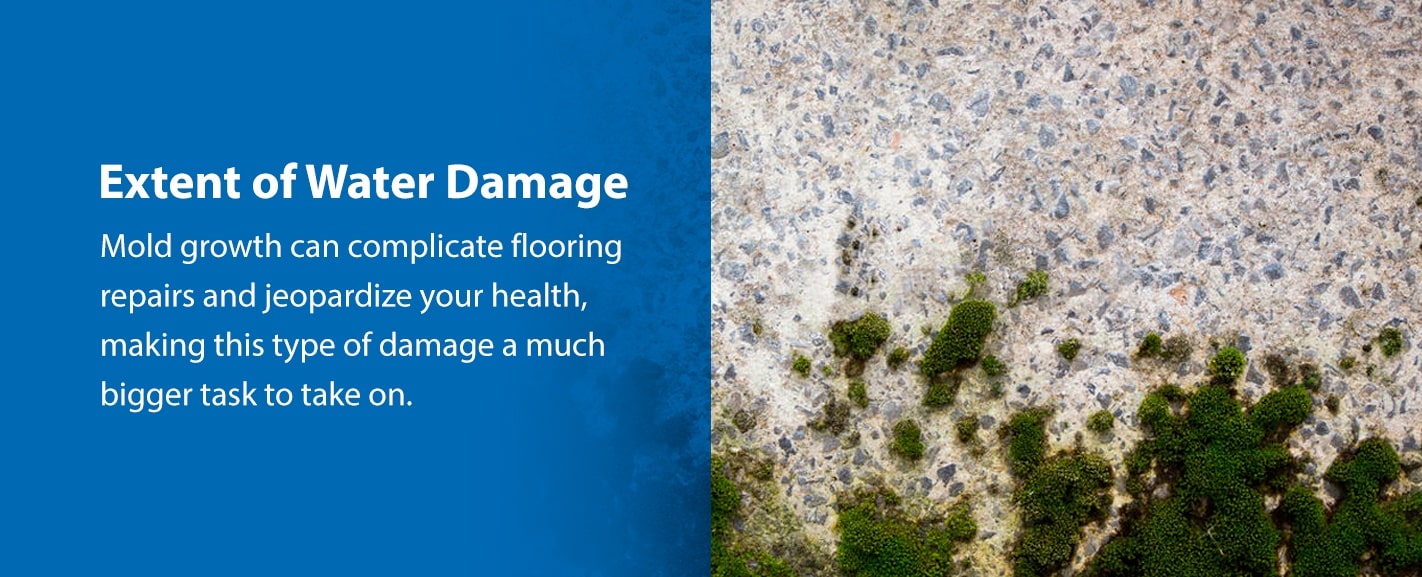

2. Type of Water
Depending on the source of the damage, you may be more inclined to replace rather than repair.
- Clean water: Water from leaking pipes is clean water — like rainwater. This type of water damage is safe to clean or repair.
- Gray water: Water from dishwashers, washing machines, and clean toilets is slightly dirty. This “gray” water may have contaminants. If you choose to clean or repair this type of water damage yourself, you’ll need to use proper safety equipment.
- Black water: Water from sewage or rivers is known as black water. The waste and bacteria it contains are serious contaminants and can cause health problems. Floor damage from water of this kind almost always requires professional replacement help.
3. DIY or Professional
The extent of water damage may dictate whether you tackle the task yourself or hand it over to the pros.
If you want to repair or replace the flooring yourself, consider whether the task is something you can reasonably accomplish. Depending on the circumstances, DIY water damage floor repair can require significant time and effort that you could save by hiring a professional. Homeowners can typically clean moldy areas of fewer than 10 square feet following the proper protocols. Beyond this, the EPA recommends consulting a professional.
4. Available Time
How much time are you able to dedicate to your damaged floors? If you have available time, you may be able to save money by taking on the task yourself. However, if you’re working or caring for a family, an in-depth DIY job may not be an option. Consider your schedule when deciding whether to take on floor damage repair or replacement.
5. Urgency
Your decision to repair or replace water damaged floors will often depend on how quickly you need the floor fixed. Is the damage in a high-traffic area of your home? Do you have young children or pets who could be injured by it? Depending on the severity of the damaged flooring and if mold is present, you may need to repair the area as quickly as possible.
When to Consider Replacing Water-Damaged Floors
Sometimes, the damage is too extensive to repair, and it’s best to just start fresh with new flooring. Or you might just be ready for a new look. Either way, you may want to consider replacing your flooring for a couple of reasons:
1. Your Subfloor and Floor Are Severely Damaged
Subflooring is the plywood or concrete support system beneath your top flooring. If you have water-damaged subfloors, you’ll likely notice your floors are swollen or lifted. They may also feel soft or squishy underfoot.
Do wet subfloors need to be replaced? Typically, the best choice for damaged subflooring is to replace the affected section, especially if it is growing mold. To reduce the chance of damaging your subfloor, thoroughly dry your wet floor as soon as possible by taking these steps:
- Remove excess water: Use wet vacuums to soak up standing water.
- Increase airflow: Open any internal doors, closets, and windows to aid airflow to the affected area.
- Dry the area: Point fans at the damaged flooring and use dehumidifiers to remove excess moisture.
If you notice mold growth during the drying process, avoid using a fan—it may spread mold spores throughout the home. Remove visible mold with appropriate protection for your eyes, nose, mouth, and hands. Keep children and individuals with weakened immune systems or breathing problems away from the affected area.
Signs you need to replace a water-damaged subfloor include:
- Loud, squeaking floorboards
- Cupping, bubbling, or cracking in the floor
- Musty smells
- Uneven or sinking floors
Addressing severely water-damaged floors can be stressful and dangerous. In many cases, it is more time- and cost-effective to start with a clean slate by replacing your subfloor as well as your floor.
2. You’re Ready for a Fresh Start
In situations where your floor is salvageable, you may still consider a replacement. As unwanted as water damage is, it can be an opportunity to install new flooring and protect your home from future incidents. When browsing flooring options, consider materials like laminate, vinyl, carpet, and tile, which protect against water. If you choose hardwood floors, be sure to take steps to waterproof and maintain it. Proper flooring maintenance will help protect your investment.
Here are some general practices to keep your floors safe:
- Be gentle on the surface: Hard shoes and furniture legs may scuff your floors. Consider taking some precautions by asking guests to remove their shoes and adding protective guards to furniture.
- Utilize rugs and carpets: For high-use areas, add some extra padding with a rug or carpet.
- Schedule regular cleaning: Vacuuming helps remove dust particles and dirt that may damage the flooring if left untouched. Establish a routine for light cleaning to extend your floors’ lifespan.
- Deep clean: It’s a good idea to periodically call in a professional cleaner to deep clean your flooring.
- Spot clean: Wipe up spills and debris as soon as possible to avoid staining.
New flooring and proper maintenance could decrease your chances of water damage in the future. If you’re ready to take action against damage, a replacement could be your best option.


3. Water Was on Your Floors Too Long
The longer water stays on your flooring, the more damage it can cause. If you can catch a leak or spill right away, the damage can be minimized, and repair may be an option. However, if your floors are exposed to water while you’re away at work or gone for multiple days, floor damage repair will likely be too extensive.
Signs water has been on your flooring for too long include:
- Boards are lifting and nails are popping out
- Mold growth
- Boards are cupping or buckling
- Stains or discoloration
4. The Water Is Contaminated
While any type of water can damage your floors, certain types of water pose more risk than others. Clean water without harmful bacteria usually comes from a leaking sink or shower. This type of water, while still able to cause damage, can be dried, and the area can be repaired.
Other types of water, including gray water, black water, and saltwater, can be more harmful to you and your floors. Black water is especially dangerous because it contains disease-carrying bacteria. This water typically comes from backed-up sewer lines, overflowing toilets, or nearby streams. Leaks involving these types of water are more likely to require replacing a water damaged floor.


When to Consider Repairing Water-Damaged Floors
If you don’t have water under your flooring and the affected area is dry within 24 to 48 hours, you may be able to repair the damaged flooring.
Before attempting a repair, ensure the floor is completely dry. Use wet vacuums to clear puddles and set up fans and dehumidifiers to dry out remaining moisture. This process may take several days, but in some cases, it may prevent damage altogether.
Floor repairs for water damage will vary depending on the type of flooring.
- Hardwood: For small-scale wood floor water damage, you may be able to nail or screw warped boards back into place. If only a few planks need removing, you’ll need to find and purchase the same species of wood and then sand and stain them to match the current flooring. Finally, apply a polyurethane finish to protect the new wood.
- Laminate: Water damage to a laminate floor may lead to swelling and separation beneath the finish. After the flooring is dry, allow the laminate several days to show signs of damage. To repair laminate flooring, follow these steps:
- Completely remove or fix the source of water.
- Gather your tools: lament planks matching your current flooring, measuring tape, hammer, goggles, floor adhesive, utility and putty knives, underlayment, and cleaning solvent.
- Remove any water-damaged planks using your putty knife.
- Inspect and dry the space and, if necessary, replace and trim the underlayment.
- Install each new plank using floor adhesive to hold them in place. Rest a weighted item on the planks to help the adhesive bond.
- Carpet: If a carpet is left wet for a long time, it will develop mold. Use a wet vacuum to remove as much water as possible, and then finish drying with fans. When dry, have a professional clean, sanitize, and deodorize it to prevent mold and mildew. If a small section of carpet located in an out-of-the-way area is damaged, you may be able to remove and replace it.
- Additional Steps:
- Use a dehumidifier and a carpet cleaning machine to remove as much moisture and mildew as possible. These can be rented for a reasonable price.
- Once the carpet is completely dry, hire a carpet cleaning expert to steam clean your carpet to prevent stains.
- Additional Steps:
- Vinyl Planks: Many homeowners use vinyl in areas like bathrooms and kitchens that are prone to water. When installed correctly, vinyl is fairly waterproof, though you may see damage after excess water coverage. When the flooring is dry, remove damaged areas and replace them with new vinyl. Because vinyl is typically laid in layers, repairing these areas may be difficult. Consider calling a professional to ensure proper installation.
- Vinyl Tile: Like vinyl planks, vinyl tile is water resistant. However, excess water can sometimes loosen tiles. When the floor is dry, identify which tiles have come loose and carefully pry them up with a screwdriver. If you are reinstalling them yourself, find a grout that matches the current grout and add the tiles back to their original locations. To ensure proper installation and keep your flooring water-tight, consider calling a professional.
- For extensive bathroom floor damage:
- Check for any mold or mildew growing. Treat this before continuing.
- Replace the subfloor if the damage is extensive.
- For extensive bathroom floor damage:
If repairing the damaged floor is possible, you will need to decide whether you want to complete the job yourself or hire a contractor. Water-damaged floor repairs can be tricky and labor-intensive if you’re inexperienced. However, if you can feasibly repair the damage yourself, you could save on hired labor costs.
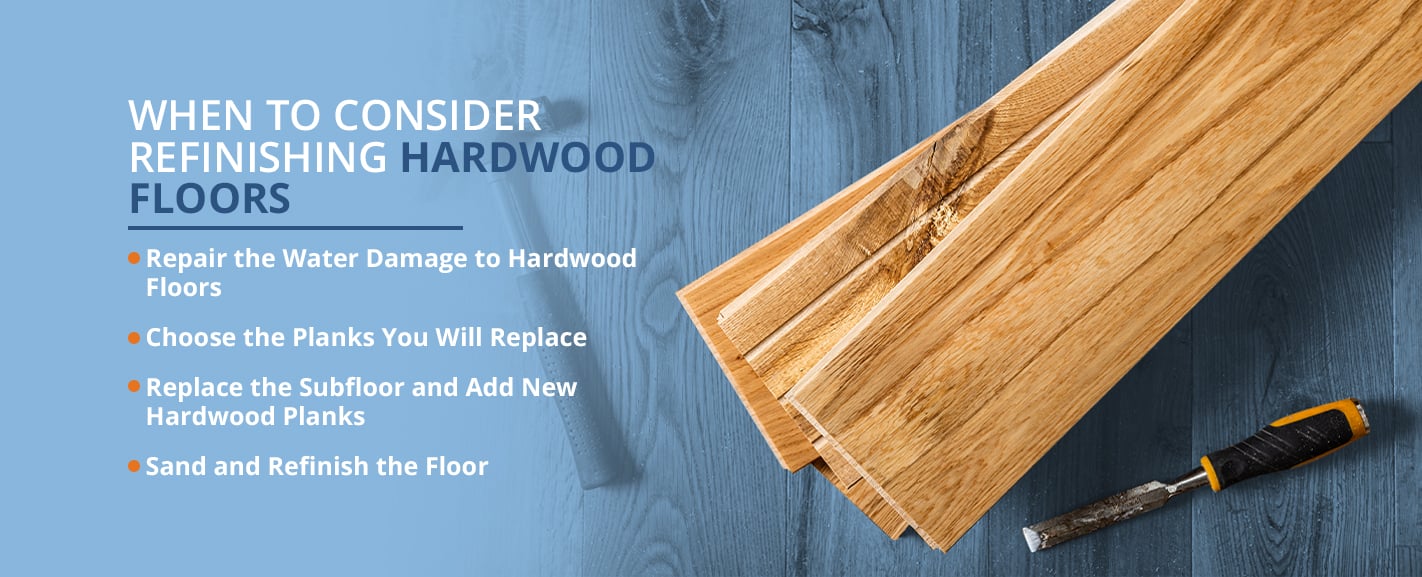

When to Consider Refinishing Hardwood Floors
If water damage to your hardwood floors is limited to slight discoloration, you can likely sand, refinish, and re-coat the affected area. It’s important to keep in mind, however, that even when using the same color stain, it can be difficult to blend the repaired areas with the surrounding floorboards. In some cases, the entire floor may need to be refinished.
If you have prefinished wood flooring, you should not try to refinish it, because the protective coating that’s applied by the factory can be difficult to match.
Follow these steps when refinishing hardwood floors.
1. Repair the Source of Water Damage
Before refinishing a hardwood floor, it’s important to resolve the source of the water damage. Make sure that you repair the cause of the water damage to ensure that further damage doesn’t occur.
2. Choose the Planks You Will Replace
Look for water damage signs to identify which planks need to be replaced. Keep in mind that water damage is not always visible, so removing surrounding planks will ensure that hidden damage doesn’t cause further problems.
3. Replace the Subfloor and Add New Hardwood Planks
Before replacing hardwood planks, it’s essential to remove any areas of the plywood subfloor that may be weakened or moldy. In the case of a concrete subfloor, you should also allow the concrete floor to dry fully before replacing the flooring.
4. Sand and Refinish the Floor
Once the new subfloor and hardwood planks are in place, you can sand, stain, and finish the floor. For the best results, consider sanding and restaining the entire floor to avoid mismatched sections.
Calculating Cost for Repairing vs. Replacing
Depending on the cause of the damage, your homeowners insurance may cover the cost of repairing or replacing a water damaged floor. Most policies will cover water damage resulting from something sudden and accidental. However, if the incident results from a known and neglected leak or home repair, you’ll likely be footing the bill.


Situations Where Water Damage Occurs
What qualifies as sudden and accidental water damage? Examples include:
- An abrupt bathroom leak that was immediately addressed: Bathtub and shower drains, disconnected drain strainers, rusty or loose water supply connections, and water valves can all cause water leaks in the bathroom.
- Ceiling damage: A sudden leak in the walls or ceiling can lead to water damaged floors.
- A burst pipe: Temperature, old age, and tree roots can cause pipes to burst, producing leaks. When cold water moves through pipes, the pipes contract and cause weak spots to burst. High temperatures or extra demand can also make pipes more vulnerable to bursts.
- Sudden kitchen appliance-related water damage: Kitchen appliances such as refrigerators and dishwashers can develop water drips from clogged filters or cracks in filter housings or lines. Dishwasher drain hoses can easily form cracks that leak water onto the floor. Center islands can make flooring vulnerable to this problem because water leaks can travel several feet when the subfloor is exposed.
- Toilet overflow: Blocked vent pipes, blocked or clogged drains, or a filler float that is set too high can all cause a toilet to overflow and cause extensive damage.
- Sudden leaking roof: Water can leak into your home from your roof, especially after walking on your roof, mishandling parts, or dropping tools. Broken seams or cracks in dried caulking can also cause roof leaks. It’s important to regularly monitor and maintain your roof to prevent leaks from occurring.
In some situations, standard homeowners insurance will not cover water damaged floors. These may include:
- Storm damage: One thing to note is the lack of flood coverage on this list. Most homeowners insurance policies exclude flood coverage, which is sold separately. Keep this in mind if your floors were damaged due to flooding from a heavy storm.
- Gradual damage to pipes: When pipes burst due to neglect, insurance may not cover the resulting water damage.
- Foundation seepage: Cracks in a home’s foundation can cause water to seep into the home. Damage caused by foundations is not typically covered.
Insurance companies expect you to do as much as possible to prevent floor damage from water. Check with your insurance agent to see if your policy covers your situation. If you’re left to pay for the repairs or replacements on your own, consider the cost of supplies, labor, and your time. It’s often cheaper to replace the damaged flooring altogether rather than have it repaired.
Considerations by Room
You might be more likely to experience water damage in your basement or bathroom, but water damage can affect every room in your home. Here’s how to approach this situation based on the room it might happen in:
Bathroom
Bathroom floors come in contact with water every day, from wet feet after showers to splashes from kids playing in the bathtub. That’s why bathroom flooring is specifically designed to handle water. So, if your bathroom floors are starting to show signs of water damage, you’ve probably got a big problem on your hands.
If you need to replace your bathroom flooring, make sure to choose an option that’s optimal for withstanding water. Talk to a flooring specialist about the best type of flooring for your needs and what the signs of water damage to look for with this particular floor style.
Kitchen
Your kitchen is another room where your floor may frequently come into contact with water or other liquids. Tile is a great option to protect your kitchen floor from minor water damage like spills. This type of flooring is also easy to clean, giving you a clean, safe kitchen to cook in.


Bedroom and Living Room
Bedroom and living room flooring focus more on the design aspect rather than functionality as we see in the bathroom or kitchen. If you love the look of your current flooring, consider applying a waterproofing treatment. If you currently have carpet, you may want to consider an alternative flooring style like engineered wood — any spills or leaks on the carpet can take longer to fully dry compared to engineered wood or another alternative.
Basement
Basement flooring can be tricky. Your basement is susceptible to water damage from flooding and groundwater in addition to leaking pipes or drains. How you utilize your basement can also factor into the flooring you choose.
If your basement is used for storage, you can pick the most protective option without worrying about how it looks. If you use it as an entertainment space, the look and comfort of the flooring may be equally important. However, it’s recommended to put extra emphasis on protection here since basements are so likely to experience water damage.
Finding the Best Fit for You
If your floor dried quickly and water damage was minimal, you may be able to repair the area. If you’ve experienced more widespread damage, replacement may be the best option.
If you’re looking for replacement flooring, 50Floor offers a convenient home shopping experience. Our experts will walk you through options to help you find the best flooring for your needs and ensure expert installation to minimize any future damage.
See flooring options in your home’s light and beside your current decor to make a fully informed decision. In cases of water heater leaks, sink overflows, and more, we also offer spot damage repair.
To take the first step toward restored flooring, schedule an appointment today.


